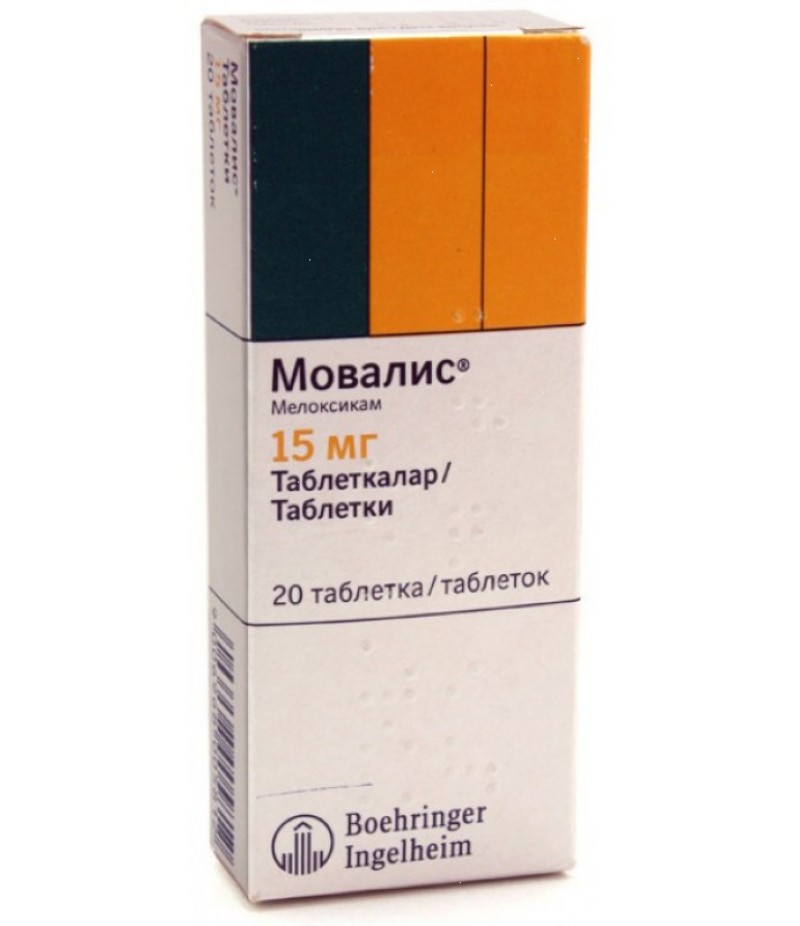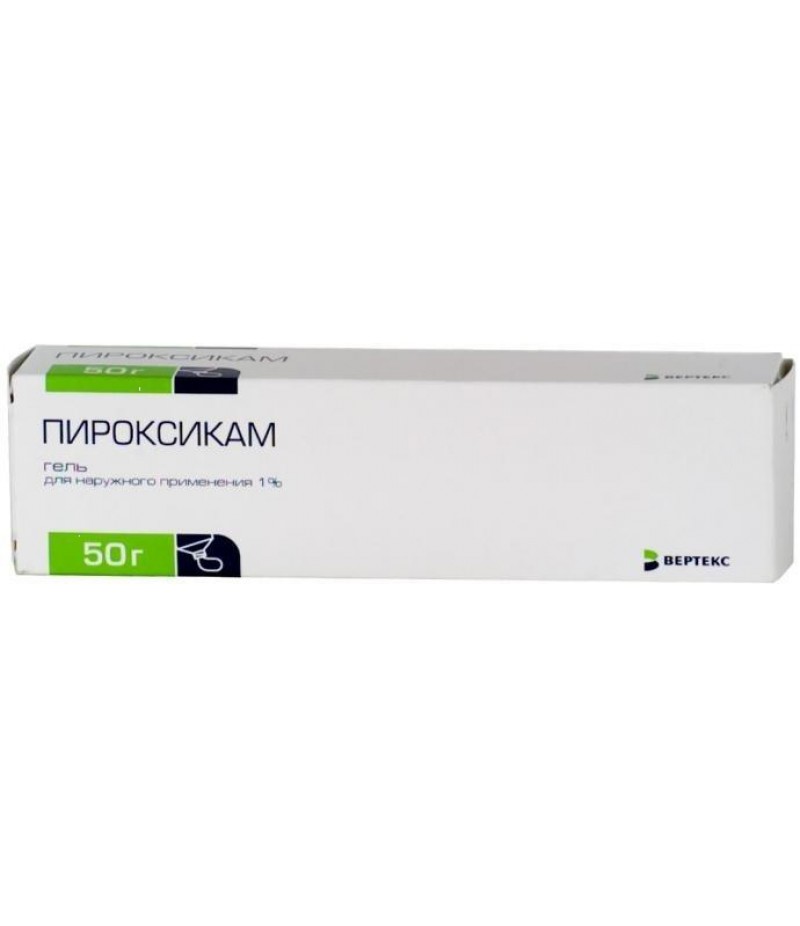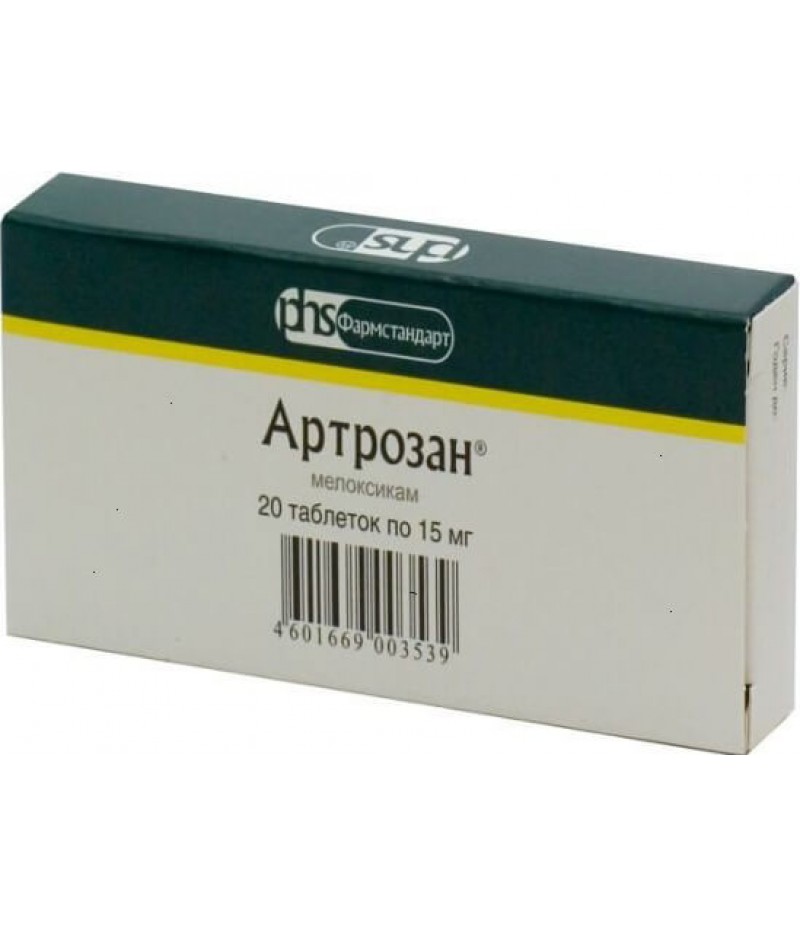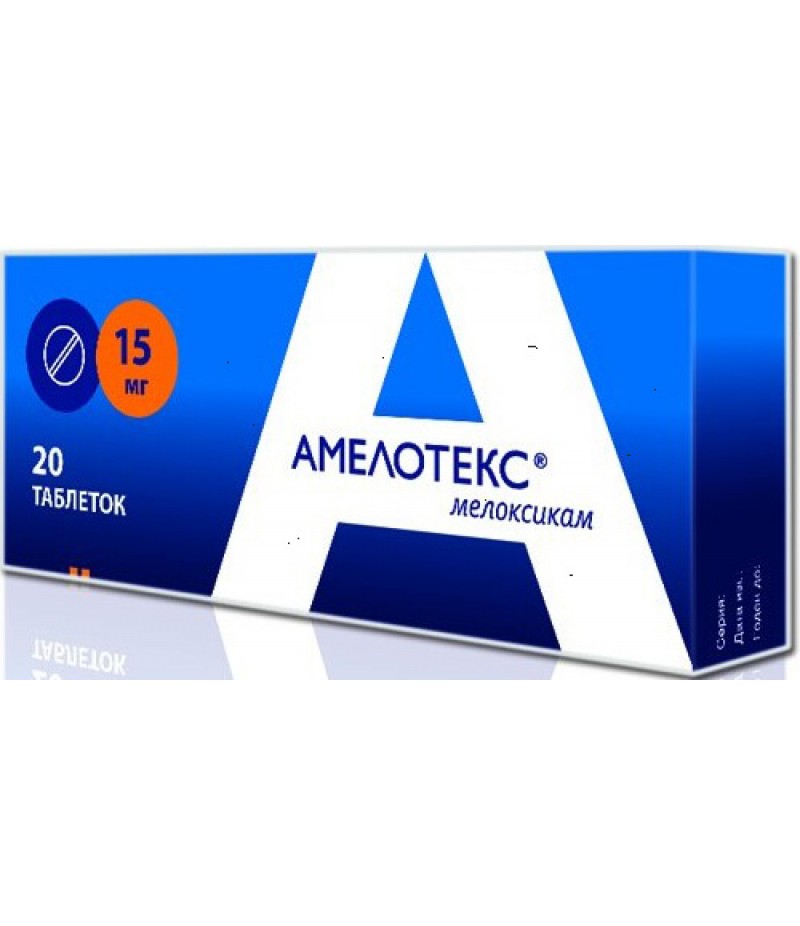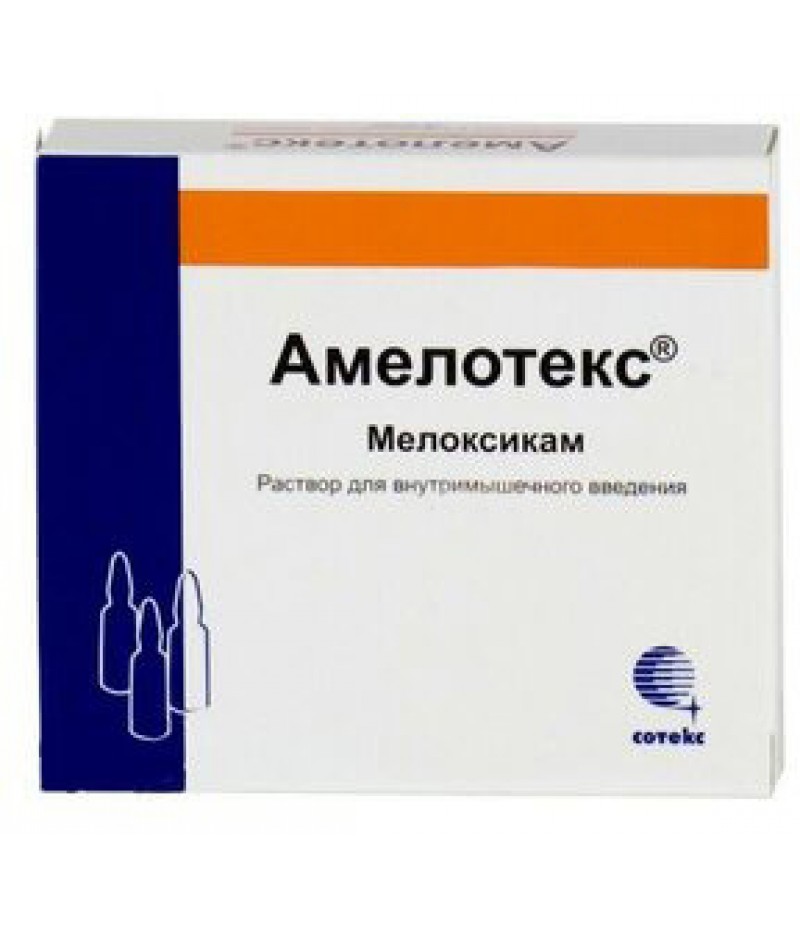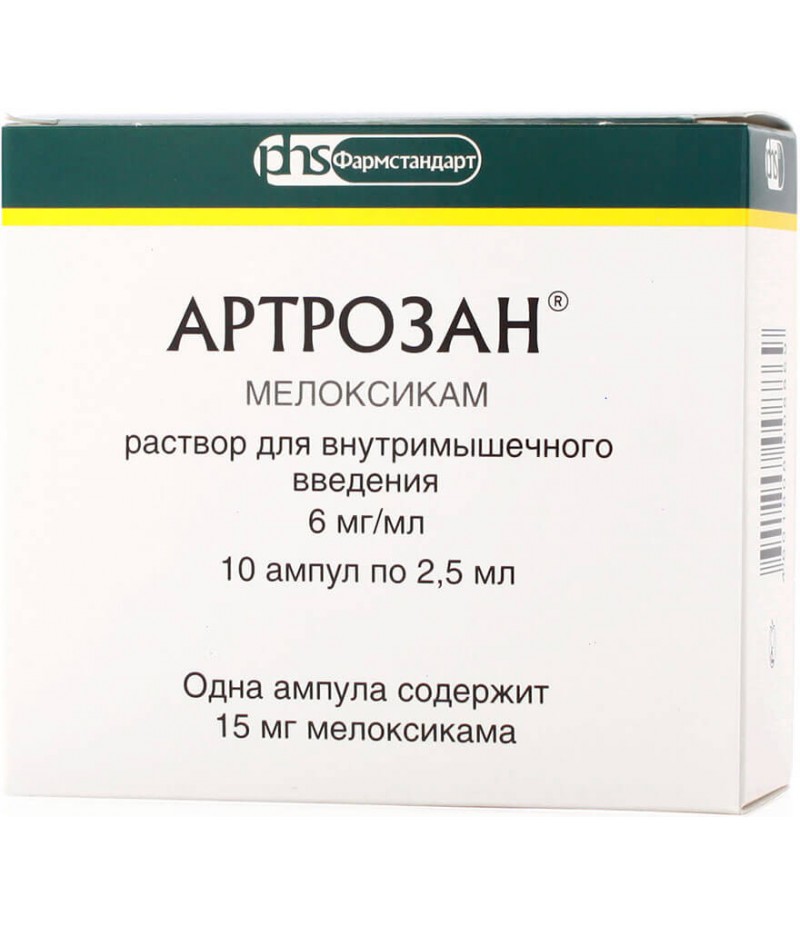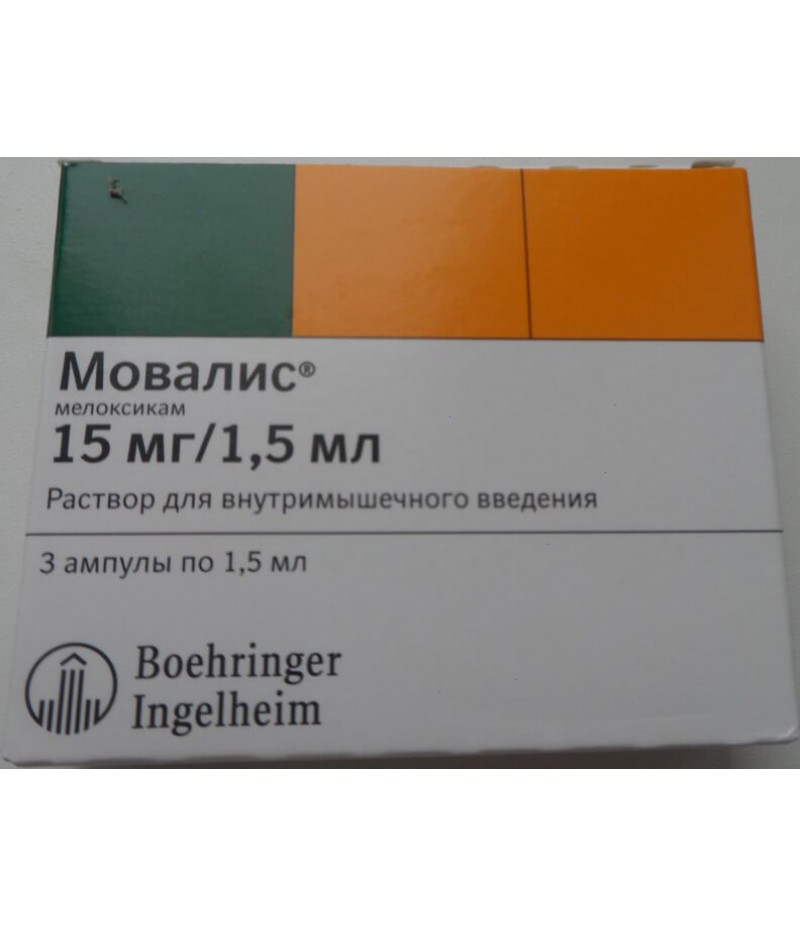Movalis 15mg #20
- $34.82
- 2 or more $32.50
- 3 or more $29.97
- Availability:In Stock
User manual for MovalisYou can buy Movalis on this pageClinical and pharmacological groupNSAIDsForm of release, composition and packagingTablets from pale yellow to yellow, round, one side convex with a beveled edge, on the convex..
Tags: tabs
User manual for Movalis
You can buy Movalis on this page
Clinical and pharmacological group
NSAIDs
Form of release, composition and packaging
Tablets from pale yellow to yellow, round, one side convex with a beveled edge, on the convex side - the firm's logo, on the other side - a code and a concave risk; roughness of tablets is allowed.
1 tab.
meloxicam 7.5 mg
Excipients: sodium citrate dihydrate - 15 mg, lactose monohydrate - 23.5 mg, microcrystalline cellulose - 102 mg, povidone K25 - 10.5 mg, silicon dioxide colloid - 3.5 mg, crospovidone - 16.3 mg, magnesium stearate - 1.7 mg.
10 pieces. - blisters (1) - packs of cardboard.
10 pieces. - blisters (2) - packs of cardboard.
Tablets from pale yellow to yellow, round, one side convex with a beveled edge, on the convex side - the firm's logo, on the other side - a code and a concave risk; roughness of tablets is allowed.
1 tab.
meloxicam 15 mg
Auxiliary substances: sodium citrate dihydrate 30 mg, lactose monohydrate 20 mg, cellulose microcrystalline 87.3 mg, povidone K25 9 mg, silicon colloidal dioxide 3 mg, crospovidone 14 mg, magnesium stearate 1.7 mg.
10 pieces. - blisters (1) - packs of cardboard.
10 pieces. - blisters (2) - packs of cardboard.
pharmachologic effect
Non-steroidal anti-inflammatory drug (NSAID), refers to the derivatives of enolic acid and has anti-inflammatory, analgesic and anti-pyretic action. The pronounced anti-inflammatory effect of meloxicam is established on all standard models of inflammation.
The mechanism of action of meloxicam is its ability to inhibit the synthesis of prostaglandins - known inflammatory mediators.
Meloksikam in vivo inhibits the synthesis of prostaglandins at the site of inflammation to a greater extent than in the mucous membrane of the stomach or kidneys. These differences are associated with a more selective inhibition of COX-2 compared to COX-1. It is believed that inhibition of COX-2 provides therapeutic effects of NSAIDs, whereas inhibition of the constantly present isoenzyme COX-1 can cause side effects on the part of the stomach and kidneys.
The selectivity of meloxicam for COX-2 has been confirmed in various test systems, both in vitro and in vivo. The selective ability of meloxicam to inhibit COX-2 is shown when using human whole blood in vitro as a test system. It was found that meloxicam (in doses of 7.5 mg and 15 mg) inhibited COX-2 more actively, having a greater inhibitory effect on the production of prostaglandin E2 stimulated by lipopolysaccharide (a reaction controlled by COX-2) than by the production of thromboxane involved in blood coagulation reaction controlled by COX-1). These effects depended on the size of the dose. Ex vivo studies have shown that meloxicam (in doses of 7.5 mg and 15 mg) has no effect on platelet aggregation and bleeding time.
In clinical trials, side effects from the gastrointestinal tract as a whole occurred less often with the use of meloxicam 7.5 mg and 15 mg than with other NSAIDs with which the comparison was made. This difference in the frequency of side effects from the gastrointestinal tract, mainly due to the fact that when taking meloxicam, there were less frequent phenomena such as dyspepsia, vomiting, nausea, abdominal pain. The frequency of perforations in the upper gastrointestinal tract, ulcers and bleeding that were associated with the use of meloxicam was low and depended on the magnitude of the dose of the drug.
Pharmacokinetics
Absorption
Meloksikam is well absorbed from the digestive tract, as evidenced by high absolute bioavailability (90%) after ingestion. After a single application of meloxicam Cmax in plasma is achieved within 5-6 hours. Simultaneous intake of food and inorganic antacids does not change the absorption. When using the drug inside (in doses of 7.5 and 15 mg), its concentrations are proportional to the doses. Steady state of pharmacokinetics is achieved within 3-5 days. The range of differences between Cmax and Cmin of the drug after its administration 1 time / day is relatively small and amounts to 0.4-1.0 μg / ml at a dose of 7.5 mg, and when using a dose of 15 mg it is 0.8-2.0 μg / ml (Cmin and Cmax during the steady state of pharmacokinetics), although values outside this range were also noted. Cmax in plasma during a stable state of pharmacokinetics is achieved 5-6 hours after ingestion.
Distribution
Meloksikam very well binds to plasma proteins, mainly with albumin (99%). It penetrates into the synovial fluid, the concentration in the synovial fluid is approximately 50% of the concentration in the plasma. The volume of distribution after repeated ingestion of meloxicam (in doses from 7.5 mg to 15 mg) is about 16 liters, with a coefficient of variation of 11 to 32%.
Metabolism
Meloksikam is almost completely metabolized in the liver with the formation of 4 pharmacologically inactive derivatives. The main metabolite, 5'-carboxymeloxicam (60% of the dose value), is formed by oxidation of the intermediate metabolite, 5'-hydroxymethylmeloxicam, which is also excreted, but to a lesser degree (9% of the dose value). In vitro studies have shown that the isoenzyme CYP2C9 plays an important role in this metabolic transformation, the isoenzyme CYP3A4 has an additional significance. In the formation of two other metabolites (which make up 16% and 4% of the dose, respectively), peroxidase takes part, the activity of which probably varies individually.
Excretion
It is excreted equally through the intestines and kidneys, mainly in the form of metabolites. In unchanged form with feces less than 5% of the daily dose is excreted, in the urine in unchanged form the drug is found only in trace amounts. The average T1 / 2 meloxicam varies from 13 to 25 hours. Plasma clearance is an average of 7-12 ml / min after a single dose of meloxicam.
Liver and / or kidney failure
Lack of liver function, as well as mild renal failure, does not significantly affect the pharmacokinetics of meloxicam. The rate of excretion of meloxicam from the body is much higher in patients with moderate renal insufficiency. Meloxicam binds worse to plasma proteins in patients with terminal renal insufficiency. In terminal renal failure, an increase in Vd can lead to higher concentrations of free meloxicam, so in these patients the daily dose should not exceed 7.5 mg.
Elderly patients
Patients older than in young patients have similar pharmacokinetic parameters. In elderly patients, the average plasma clearance during the equilibrium state of pharmacokinetics is slightly lower than in young patients. Older women have higher AUC values and a longer T1 / 2, compared to young patients of both sexes.
Indications
Symptomatic treatment:
- osteoarthritis (arthrosis, degenerative diseases of the joints), incl. with a painful component;
- rheumatoid arthritis;
Ankylosing spondylitis;
- other inflammatory and degenerative diseases of the musculoskeletal system, such as arthropathies, dorsopathies (eg, sciatica, lower back pain, shoulder periarthritis), accompanied by pain.
Contraindications
- complete or incomplete combination of bronchial asthma, recurrent nasal polyposis and paranasal sinuses, angioedema or urticaria caused by intolerance to acetylsalicylic acid or other NSAIDs (including in anamnesis) because of the existing probability of cross-sensitivity;
- erosive and ulcerative lesions of the stomach and duodenum in the acute stage or recently transferred;
- Inflammatory bowel disease (Crohn's disease or ulcerative colitis in the acute stage);
Hepatic failure of severe degree;
- renal failure of severe degree (if hemodialysis is not performed, CC <30 ml / min, and also with confirmed hyperkalemia);
- progressive kidney disease;
- active gastrointestinal bleeding, recent cerebrovascular bleeding or an established diagnosis of coagulation system diseases;
- severe uncontrolled heart failure;
- therapy of perioperative pain during coronary artery bypass grafting;
- Pregnancy;
- the period of lactation (breastfeeding);
- children's age till 12 years;
- a rare hereditary intolerance of galactose (in the maximum daily dose of the drug with dosage of meloxicam 7.5 mg and 15 mg contains 47 mg and 20 mg of lactose, respectively);
- Hypersensitivity to the active substance or auxiliary components of the drug.
Carefully:
- Gastrointestinal diseases in the anamnesis (peptic ulcer of stomach and duodenum, liver disease);
Congestive heart failure;
- renal failure (CK 30-60 ml / min);
- IHD;
- cerebrovascular diseases;
- dyslipidemia / hyperlipidemia;
- diabetes;
- concomitant therapy with the following drugs: oral GCS, anticoagulants (including warfarin), antiaggregants, selective serotonin reuptake inhibitors (including citalopram, fluoxetine, paroxetine, sertraline);
- diseases of peripheral arteries;
- elderly age;
- prolonged use of NSAIDs;
- Smoking;
- frequent use of alcohol.
Dosage
The drug is taken orally 1 time / day, during meals, washed down with water or other liquid.
In osteoarthritis with pain, the daily dose is 7.5 mg, if necessary, the dose can be increased to 15 mg / day.
With rheumatoid arthritis the drug is prescribed in a dose of 15 mg / day, depending on the therapeutic effect, the dose can be reduced to 7.5 mg / day.
With ankylosing spondylitis, the drug is prescribed at a dose of 15 mg / day, depending on the therapeutic effect, the dose can be reduced to 7.5 mg / day.
The maximum recommended daily dose is 15 mg.
In patients with an increased risk of adverse reactions (a history of GI disease, the presence of risk factors for cardiovascular disease), it is recommended to start treatment with a dose of 7.5 mg / day.
Because the potential risk of adverse reactions depends on the dose and duration of treatment, the minimum effective dose should be given as little as possible by a short course.
In patients with severe renal failure who are on hemodialysis, the dose of Mawalis should not exceed 7.5 mg / day.
The maximum dose for adolescents aged 12-18 years is 0.25 mg / kg and should not exceed 15 mg.
The use of the drug is contraindicated in childhood to 12 years, due to the inability to select the appropriate dose for this age group.
Combined application
Do not use the drug simultaneously with other NSAIDs.
The total dose of the drug Movalis, used in the form of different dosage forms, should not exceed 15 mg / day.
Side effects
Below are described the side effects, the relationship of which with the use of the drug Movalis, was regarded as possible.
Side effects, registered with post-marketing application, the connection of which with taking the drug was regarded as possible, marked with *.
Within the system-organ classes, the following categories are used for the incidence of side effects: very often (≥1 / 10); often (≥1 / 100, <1/10); infrequently (≥1 / 1000, <1/100); rarely (≥1 / 10,000, <1/1000); very rarely (<1/10 000); not installed.
On the part of the blood and lymphatic system: infrequently - anemia; rarely - a change in the number of blood cells, including changes in the leukocyte formula, leukopenia, thrombocytopenia.
From the immune system: infrequently - other immediate-type hypersensitivity reactions *; frequency not established - anaphylactic shock *, anaphylactoid reactions *.
From the nervous system: often - headache; infrequently - dizziness, drowsiness.
Mental disorders: often - changes in mood *; frequency not established - confusion *, disorientation *.
From the senses: infrequently - vertigo; rarely - conjunctivitis *, visual impairment, including blurred vision *, tinnitus.
From the gastrointestinal tract: often - abdominal pain, indigestion, diarrhea, nausea, vomiting; infrequently - latent or obvious gastrointestinal bleeding, gastritis *, stomatitis, constipation, bloating, eructation; rarely - gastroduodenal ulcers, colitis, esophagitis; very rarely - perforation of the gastrointestinal tract.
On the part of the liver: infrequently - transient changes in liver function (for example, increased activity of transaminases or bilirubin concentrations); very rarely - hepatitis *.
From the skin and subcutaneous tissues: infrequently - angioedema, * itching, skin rash; rarely - toxic epidermal necrolysis *, Stevens-Johnson syndrome *, urticaria; very rarely - bullous dermatitis *, erythema multiforme *; frequency not established - photosensitivity.
On the part of the respiratory system: rarely - bronchial asthma in patients with an allergy to acetylsalicylic acid or other NSAIDs.
From the side of the cardiovascular system: infrequently - increased blood pressure, a feeling of "tide" of blood to the face; rarely - a feeling of palpitations.
From the urinary system: infrequently - changes in renal function (increased serum creatinine and / or urea levels), urination disorders, including acute urinary retention *; very rarely acute renal failure.
From the genitals and the breast: infrequently - late ovulation *; frequency is not established - infertility in women *.
Joint application with drugs that inhibit bone marrow hematopoiesis (for example, methotrexate) can provoke cytopenia.
Gastrointestinal bleeding, ulcer or perforation can lead to death.
As for other NSAIDs, the possibility of interstitial nephritis, glomerulonephritis, renal medullary necrosis, nephrotic syndrome is not excluded.
Overdose
Data on cases associated with drug overdose accumulated insufficiently. Presumably, symptoms typical of an NSAID overdose will be present in severe cases: drowsiness, impaired consciousness, nausea, vomiting, epigastric pain, gastrointestinal bleeding, acute renal failure, changes in blood pressure, respiratory arrest, asystole.
Treatment: the antidote is unknown, in case of an overdose of the drug, evacuation of the stomach contents and general maintenance therapy should be carried out. Kolestyramin accelerates the excretion of meloxicam.
Drug Interactions
At simultaneous application with meloxicam of other inhibitors of synthesis of prostaglandins, incl. GCS and salicylates, the risk of formation of gastrointestinal ulcers and gastrointestinal bleeding increases (due to synergism of action). Simultaneous use of meloxicam and other NSAIDs is not recommended.
Anticoagulants for oral administration, heparin for systemic administration, thrombolytic agents with simultaneous application with meloxicam increase the risk of bleeding. In the case of simultaneous use, careful monitoring of the blood coagulation system is necessary.
Antiplatelet agents, serotonin reuptake inhibitors with simultaneous use with meloxicam increase the risk of bleeding due to inhibition of platelet function. In the case of simultaneous use, careful monitoring of the blood coagulation system is necessary.
NSAIDs increase the concentration of lithium in the plasma by reducing the excretion of lithium by the kidneys. The simultaneous use of meloxicam with lithium preparations is not recommended. In case of need for simultaneous use, careful monitoring of lithium concentration in plasma is recommended during the whole course of lithium preparations.
NSAIDs decrease the tubular secretion of methotrexate, thereby increasing its concentration in the plasma. The simultaneous use of meloxicam and methotrexate (at a dose of more than 15 mg per week) is not recommended. In the case of simultaneous use, careful monitoring of kidney function and blood count is necessary. Meloxicam may increase the hematologic toxicity of methotrexate, especially in patients with impaired renal function. With the combined use of meloxicam and methotrexate for 3 days, the risk increases the toxicity of the latter.
There is evidence that NSAIDs may reduce the effectiveness of intrauterine contraceptive devices, but this has not been proven.
The use of NSAIDs with diuretics in the case of dehydration of patients is accompanied by a risk of acute renal failure.
NSAIDs reduce the effect of antihypertensive agents (beta-blockers, ACE inhibitors, vasodilators, diuretics) due to the inhibition of prostaglandins with vasodilating properties.
The combined use of NSAIDs and angiotensin II receptor antagonists, as well as ACE inhibitors, enhances the effect of reducing glomerular filtration, thereby leading to the development of acute renal failure, especially in patients with impaired renal function.
Kolestyramin, binding meloxicam in the digestive tract, leads to its faster excretion.
NSAIDs, acting on renal prostaglandins, can enhance the nephrotoxicity of cyclosporine.
In patients with SC from 45 to 79 ml / min, the use of meloxicam should be discontinued 5 days before the start of pemetrexed and may be resumed 2 days after the end of pemetrexed. If there is a need for the combined use of meloxicam and pemetrexed, patients should be closely monitored, especially with respect to myelosuppression and the occurrence of side effects from the gastrointestinal tract. In patients with SC <45 ml / min, the use of meloxicam in conjunction with pemetrexed is not recommended.
When medications that have a known ability to inhibit CYP2C9 and / or CYP3A4 (or are metabolized with the participation of these enzymes), such as sulfonylureas or probenecid derivatives, should be taken into account with meloxicam, the possibility of pharmacokinetic interaction should be taken into account.
When combined with antidiabetic agents for oral administration (for example, sulfonylurea derivatives, nateglinide), CYP2C9 mediated interaction may occur, which may lead to an increase in the concentration of both hypoglycemic agents and meloxicam in the blood. Patients concurrently taking meloxicam with sulfonylureas or nateglinide drugs should carefully monitor blood glucose levels because of the potential for hypoglycemia.
With the simultaneous use of antacids, cimetidine, digoxin and furosemide, no significant pharmacokinetic interaction was identified.
special instructions
Patients with gastrointestinal diseases should be observed on a regular basis. If there is a gastrointestinal lesion of the gastrointestinal tract or gastrointestinal bleeding, Mawalis should be canceled.
Gastrointestinal ulcers, perforation or bleeding can occur during the use of NSAIDs at any time, either with the presence of alarming symptoms or information about serious gastrointestinal complications in the anamnesis, or in the absence of these symptoms. The consequences of these complications are generally more serious in the elderly.
When using the drug Movalis, such serious skin reactions as exfoliative dermatitis, Stevens-Johnson syndrome, toxic epidermal necrolysis can develop. Therefore, special attention should be given to patients reporting the development of undesirable skin and mucous membrane phenomena, as well as hypersensitivity reactions to the drug, especially if similar reactions were observed during previous courses of treatment. The development of such reactions is observed, as a rule, during the first month of treatment. In the case of the appearance of the first signs of skin rash, changes in mucous membranes or other signs of hypersensitivity, the question of discontinuing the use of the drug Mawalis should be considered.
Cases of increased risk of serious cardiovascular thrombosis, myocardial infarction, angina attack, possibly fatal, with NSAIDs are described. This risk increases with prolonged use of the drug, as well as in patients with the above mentioned diseases in the history and predisposed to such diseases.
NSAIDs inhibit the synthesis of prostaglandins in the kidneys, which are involved in maintaining renal perfusion. The use of NSAIDs in patients with reduced renal blood flow or reduced BCC can lead to decompensation of the secretive renal failure. After the abolition of NSAIDs, the kidney function is usually restored to its original level. The elderly patients, patients with dehydration, congestive heart failure, cirrhosis, nephrotic syndrome or acute renal dysfunction, patients concurrently taking diuretic drugs, ACE inhibitors, angiotensin II receptor antagonists are most at risk of developing this reaction, and also patients who underwent serious surgical interventions that lead to hypovolemia. In such patients at the beginning of therapy, diuresis and renal function should be carefully monitored.
The use of NSAIDs in conjunction with diuretics can lead to a delay in sodium, potassium and water, as well as a decrease in natriuretic action of diuretics. As a result, predisposing patients may have signs of heart failure or hypertension. Therefore, careful monitoring of the condition of such patients is needed, as well as maintenance of adequate hydration. Before the beginning of treatment it is necessary to study the function of the kidneys.
In the case of combined therapy, kidney function should also be monitored.
When using the drug Movalis (as well as the majority of other NSAIDs), an episodic increase in the activity of transaminases or other indicators of liver function in serum was reported. In most cases, this increase was small and transient. If the identified changes are significant or do not decrease over time, Movalis should be discontinued and observed for identified laboratory changes.
Weakened or debilitated patients can tolerate undesirable events worse, so these patients need careful monitoring.
Like other NSAIDs, Movalis can mask the symptoms of an infectious disease.
As a drug that inhibits the synthesis of COX / prostaglandin, Movalis can affect fertility, and therefore is not recommended for women who have difficulty with conception. In women undergoing examination in this regard, it is recommended to cancel the use of the drug Movalis.
In patients with mild to moderate renal failure (CK> 25 mL / min), dose adjustment is not required.
In patients with cirrhosis of the liver (compensated), dose adjustment is not required.
Impact on the ability to drive vehicles and manage mechanisms
Special clinical studies of the effect of the drug on the ability to control the car and mechanisms were not carried out. However, when driving and working with machinery, one should take into account the possibility of developing dizziness, drowsiness, visual impairment, or other abnormalities from the CNS. Patients should be careful when driving and controlling machinery.
Pregnancy and lactemia
The use of the drug Movalis is contraindicated in pregnancy.
It is known that NSAIDs are excreted in breast milk, therefore the use of the drug Movalis during breastfeeding is contraindicated.
As a preparation that inhibits the synthesis of COX / prostaglandin, Movalis can affect fertility, and therefore is not recommended for women planning a pregnancy. Meloksikam can lead to a delay in ovulation. In this regard, women who have problems with conception and undergoing examination for such problems, it is recommended to cancel taking the drug Movalis.
Application in childhood
Contraindicated in children under the age of 12 years.
In case of violations of kidney function
The drug is contraindicated in patients with severe renal insufficiency (if hemodialysis is not performed, CC <30 ml / min, and also with confirmed hyperkalemia), progressive kidney disease.
With caution should prescribe the drug for kidney failure (KK 30-60 ml / min).
In patients with severe renal failure who are on hemodialysis, the dose should not exceed 7.5 mg / day.
In patients with mild to moderate renal failure (CK> 25 mL / min), dose adjustment is not required.
With violations of liver function
The drug is contraindicated in cases of severe hepatic insufficiency.
In patients with cirrhosis of the liver (compensated), dose adjustment is not required.
Application in old age
Caution should be given to elderly patients.
Terms and conditions of storage
The drug should be stored out of the reach of children at a temperature of no higher than 25 ° C. Shelf life - 3 years.

